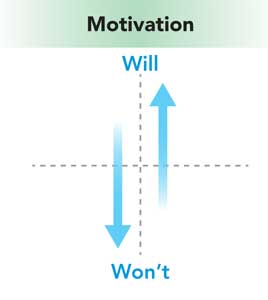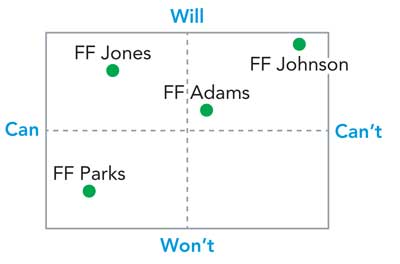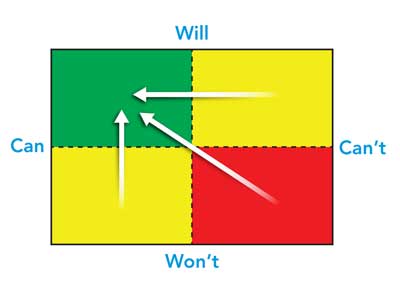BY KEVIN PARKER
As a fire department leader, how do you spend your time? As a leader in business and a 30-year fire service veteran, I know that it is very easy to get caught up in the “busyness” of the job. With e-mail, paperwork, personnel matters, and other “time monsters,” we tend to get bogged down in our job’s administrative elements, which may trick us into thinking that we must be doing all the right things simply because we are busy. Be warned! Being busy and being effective are two very different things, particularly when it comes to proactively moving our departments forward.
In all of our busyness, perhaps the most important area that we tend to neglect is firefighter development. Since personnel are clearly our most important (and with career departments, most expensive) assets, failure to recognize the importance of our firefighters’ growth and development is, at best, career limiting and, at worst, threatening to the lives of our members and the citizens we serve.
One of the greatest mistakes a fire service leader can make is to assume that firefighters, once hired and initially trained, are very similar in terms of their needs and motivations. The reality is that firefighter development is very similar to the very beast they spend their careers fighting: fire. Firefighters, like fires, have stages of development as they progress and, as we know, failure to recognize the stage that the fire is in can result in tactical decisions that may have undesirable outcomes.
FIRE STAGES AND PERSONNEL DEVELOPMENT
A new firefighter is similar to the incipient stage of a fire: The fire seeks unburned fuel and begins to generate enough heat to sustain combustion and fire spread. Similarly, the new firefighter, like a sponge, absorbs everything he can to ensure the survival and future success in his career.
An experienced firefighter is akin to a free-burning fire that has all the ingredients necessary to support combustion. The firefighter has had enough training and minimal experience, which typically results in a well-oiled firefighting machine that is bright, enthusiastic, and energetic. It takes more water to cool down a good free-burning fire just as it takes a lot to wear down a more experienced firefighter.
A veteran/tenured firefighter is similar to an oxygen-deprived fire. It has done its work, consumed much of the fuel, and now seeks additional oxygen to renew itself. The tenured firefighter has what it takes to be a tremendous asset to the fire department and requires both attention and targeted use of his assets to maximize his motivation and efficiency. As is the case when ignoring the signs of a smoldering phase fire, turning our backs and ignoring the veteran firefighter could have negative results. You must respect and pay special attention to the tenured firefighter just as you do to an advanced-stage fire.
What can you do as a fire service leader to develop your members as they progress throughout their careers? Let’s look at how to dynamically assess your team to determine the best development plan (Table 1).

DEVELOPING FIREFIGHTERS IN STAGES
The new (rookie) firefighter thirsts for knowledge and experience. Most departments have mastered the basic training component for rookie firefighters, but experience varies from department to department. Be mindful, however, that new firefighters will learn most effectively from kinesthetic (hands-on) learning and each experience builds their repertoire for future actions and decisions. Your role as a fire service leader is to ensure that you maximize experiential learning opportunities for the rookie firefighter and create positive, rewarding influences for him; constant direction and feedback is your number-one priority for these firefighters. Remember, an incipient stage fire can be influenced easily by a number of factors and can grow quickly, but it can also be extinguished easily!
An experienced firefighter, like a free-burning fire, presents both the greatest risk and the greatest opportunity for fire service leaders. Since these firefighters are generally more secure, confident, and knowledgeable than ever before, their actions and decisions must also be constantly monitored and directed. These firefighters are oftentimes risk takers and (depending on the department) may not have the level of experience required to recognize significant hazards, which could potentially endanger themselves and others. Consequently, your areas of coaching focus for these firefighters are safety and hazard identification (e.g., reading smoke conditions) and tactical decision making. Conduct incident reviews following significant incidents with these firefighters. Also, tap these firefighters to train and motivate others. Finally, encourage them to specialize in specific areas (e.g., hazmat, technical rescue team, special response team, and so on) to ensure they are constantly challenged and developed.
Finally, one of your greatest challenges as a fire service leader is managing the development of tenured (preretirement) firefighters. Like the oxygen-deprived fire, tenured firefighters have put in their time and may be tired and burnt out and have their eyes on the “retirement prize.” It is not uncommon for these tenured firefighters to experience “paradigm paralysis,” holding on to outdated and antiquated values, beliefs, processes, and technologies. Be mindful of the impact outdated thinking may have on other personnel; it may be contrary to the fire department’s direction and undermine what fire department leaders are trying to accomplish. Failure to pay attention to these tenured firefighters could really create problems if left unchecked.
Fortunately, tenured firefighters are generally your most important (and often untapped) assets! Tenured firefighters become toxic when you fail to develop and listen to them. We simply stop paying attention to them and assume that they no longer need our assistance or direction. We combat this by staying engaged at their motivational level. In other words, you must understand what motivates them now since their lives have changed and they are no longer motivated by the same life elements as when they were younger firefighters.
In my consulting practice, I always recommend that when business leaders begin a formal coaching program, they begin by coaching the best sales representative or most tenured employee first. The same holds true for your tenured firefighters-coach them first! Others will then perceive the coaching process as being positive since the most tenured firefighters experience it first.
ASSESSMENT IS KEY!
As firefighters progress throughout their careers, they experience a number of changes as their personal needs evolve. For example, although a young rookie firefighter might be single without children, a more tenured firefighter might be struggling with family demands, health issues, and so on. As a result, constantly monitor firefighters as the motivations and skills required to perform their specific functions change.
Understand the importance of assessing all firefighters at various stages of their careers, from a motivational as well as an aptitude perspective. Sometimes, your most skilled firefighters can be your biggest leadership challenges because of attitude issues; the opposite is also sometimes true. Most chief officers and training officers might recall firefighters who were highly motivated with positive attitudes who simply could not grasp the skills needed to be effective firefighters, engineers, or officers. However, many of us can recall skilled firefighters who eventually met their fire service career demise simply through persistent poor attitudes.
In assessing firefighters, I employ a very simple grid that creates a great starting point to identify a course of action for their development (Figure 1). On the vertical axis, the motivational level of the firefighter is identified-the “will/won’t” axis. The firefighter may be highly willing (desirous), somewhat willing, not very willing, or simply won’t do the job he is asked to do. Based on your assessment, plot the levels up and down the axis where you believe they fall.
| Figure 1. |
 |
This is very different from one’s ability (or capability) to do the job (Figure 2). On the horizontal axis, one’s ability to perform his functions as a firefighter, a driver, or an officer is identified. For example, he may be very capable and “can” do the job, he is somewhat competent and somewhat capable, or he may not be capable and simply “can’t” perform the job. Again, move across the axis to determine the competency of the firefighter.
| Figure 2. |
 |
Once you have evaluated both attitude and skill, plot your firefighters and begin to identify action plans for your team. Figure 3 shows a completed grid for four members.
| Figure 3. |
 |
Once you have completed this phase, develop your plan. For example, “Firefighter Johnson” is highly motivated to perform his job (will), but he is also very low on the capability axis (can’t). In this case, it may be the best course of action to identify Firefighter Johnson’s skill deficiencies and then develop the necessary curricula, provide training, and monitor and reevaluate his progress after a specified time period.
“Firefighter Jones,” on the other hand, should be rewarded, encouraged to continue his development, and groomed for future leadership (if he so desires), whereas Firefighter Parks might be counseled on his performance and placed on a performance plan because of attitudinal deficiencies even though he may be skilled in his position.
Although your goal is to keep and move your team in the “can/will” quadrant, keep in mind that firefighters will move within the same quadrant and from quadrant to quadrant as they progress throughout their careers. Factors impacting movement within and from quadrant to quadrant include but are not limited to the following:
- Rank changes. Some positions may challenge the competencies/aptitudes of firefighters/officers (can/can’t).
- Personal issues. Familial and financial problems may impact how one is motivated (will/won’t).
- Health and fitness changes. This may impact capabilities (can/can’t).
- Department financial concerns. Fewer pay increases and reduction in employee benefits/programs may impact motivation (will/won’t).
Refer to Figure 4. Here, your goal is to assess, monitor, coach, counsel, and develop toward the “can/will” (green) quadrant. Firefighters remaining in the “can’t/won’t” (red) quadrant will require performance counseling and must clearly understand measures they must take to improve in both attitude and aptitude. A clear, well-documented plan is certainly a high priority for these firefighters.
| Figure 4. |
 |
Finally, take a couple of hours during one day (mark the time off your “busy” calendar) to evaluate every member of your department. Next, meet with your leadership team to determine the agreed-on areas of development for each firefighter and officer. When meeting with each individual firefighter/officer, take time to truly ask him how he is doing. Make certain you are aware of what motivates your firefighters and ask them what excites them about coming to work or to the firehouse. Review their aspirations, and be certain to share your observations with them as well.
It is important for fire service leaders to understand how their teams react to internal and external influences and how their firefighters change throughout their careers. Take the time to listen, understand, and develop a plan for your team. You might find that the time spent on this exercise is the best thing you can do for your department-protecting and developing your most important assets: people!
KEVIN PARKER is a 30-year fire service veteran and an assistant chief with South Oldham Fire Department in Crestwood, Kentucky. Parker is also a consultant, a speaker, and a trainer.
Fire Engineering Archives

